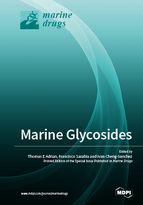Marine Glycosides
A special issue of Marine Drugs (ISSN 1660-3397).
Deadline for manuscript submissions: closed (31 May 2018) | Viewed by 68437
Special Issue Editors
Interests: identification of novel growth-related cancer therapeutic targets; cancer stem cells; lipoxygenase pathways in cancer; molecular mechanisms of cancer cachexia; drug combination studies
Interests: natural products; bioactive compounds; total synthesis; antitumor; antibiotics; cyclodepsipeptides; cyclopeptides
Special Issues, Collections and Topics in MDPI journals
Interests: total synthesis; natural products; medicinal chemistry
Special Issues, Collections and Topics in MDPI journals
Special Issue Information
Dear Colleagues,
In recent years, there has been a steady increase in the publication of papers on the chemistry, biology, and potential clinical uses of marine glycosides. Indeed, more than half of the papers published in this field are less than a decade old. Glycosides have been isolated from species as diverse as algae, fungi, anthozoans, and echinoderms. Even fish of the genus Pardachirus produce glycosides that they use as shark repellents.
The major interest in these compounds as potential drugs stems from the broad spectrum of biological effects. They have been shown to have antimicrobial, antifungal, anti-inflammatory, immune modulatory immune modulatory and anticancer effects. The anticancer effects of marine glycosides include cell cycle suppression, induction of apoptosis, inhibition of migration, invasion and metastasis, as well as antiangiogenesis. Marine glycosides influence membrane permeability and at the molecular level, have been shown to influence membrane transport through effects on transport carriers and pumps, as well as effects on ligand-gated and voltage-gated channels. Various marine glycosides have been shown to activate sphingomyelinase and ceramide synthesis, to inhibit topoisomerase activity, receptor tyrosine kinase activity, multidrug resistance protein activity and to antagonize eicosanoid receptors.
This Special Issue will cover the entire scope of marine organism-derived glycosides that are of potential value as pharmaceutical agents or leads. These include, but are not limited to, tetracyclic triterpene glycosides; other triterpene glycosides; steroid glycosides; and glycosides of non-isoprenoid aglycones.
Prof. Dr. Thomas E Adrian
Prof. Dr. Francisco Sarabia
Dr. Ivan Cheng
Guest Editors
Manuscript Submission Information
Manuscripts should be submitted online at www.mdpi.com by registering and logging in to this website. Once you are registered, click here to go to the submission form. Manuscripts can be submitted until the deadline. All submissions that pass pre-check are peer-reviewed. Accepted papers will be published continuously in the journal (as soon as accepted) and will be listed together on the special issue website. Research articles, review articles as well as short communications are invited. For planned papers, a title and short abstract (about 100 words) can be sent to the Editorial Office for announcement on this website.
Submitted manuscripts should not have been published previously, nor be under consideration for publication elsewhere (except conference proceedings papers). All manuscripts are thoroughly refereed through a single-blind peer-review process. A guide for authors and other relevant information for submission of manuscripts is available on the Instructions for Authors page. Marine Drugs is an international peer-reviewed open access monthly journal published by MDPI.
Please visit the Instructions for Authors page before submitting a manuscript. The Article Processing Charge (APC) for publication in this open access journal is 2900 CHF (Swiss Francs). Submitted papers should be well formatted and use good English. Authors may use MDPI's English editing service prior to publication or during author revisions.
Keywords
-
Marine glycosides
-
Triterpene glycosides
-
Steroid glycosides
-
Glycolipids
-
Glycosides of non-isoprenoid aglycones
-
Cancer
-
İnflammation
-
Antitumoral
-
Anti-microbial
-
Anti-fungal
-
İmmune modulation







